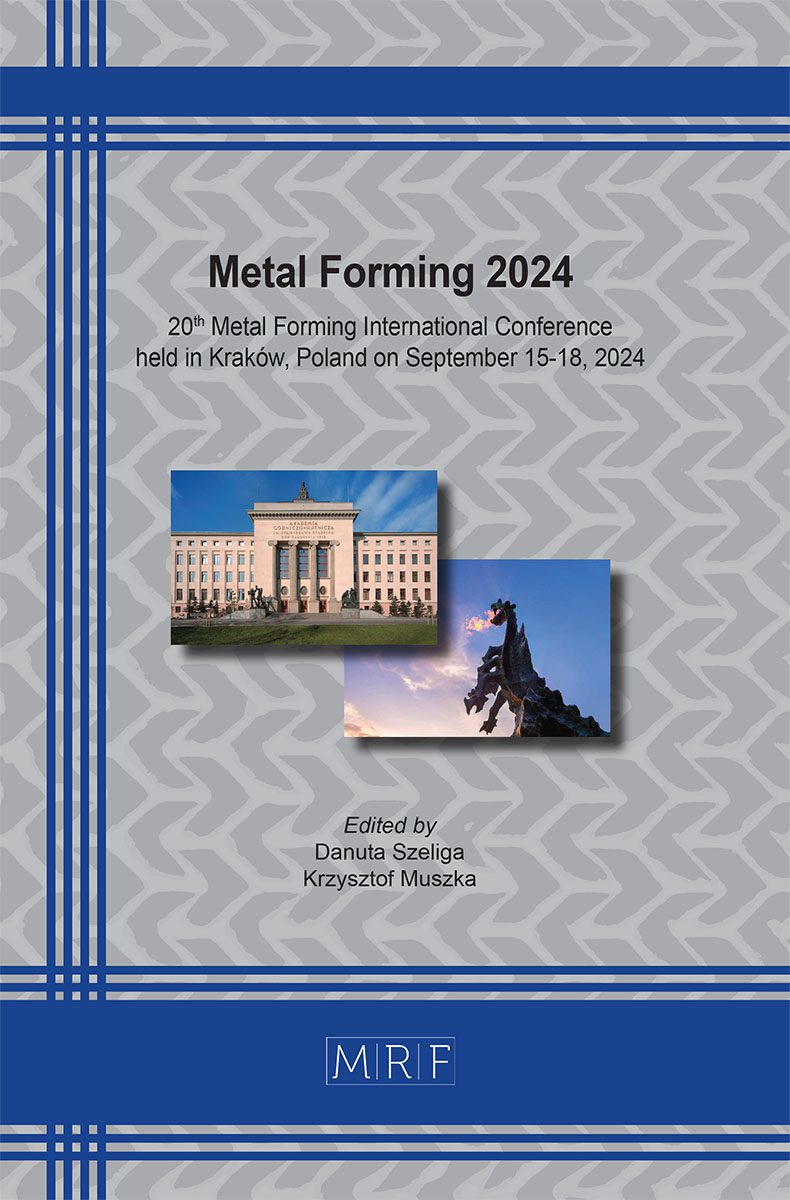–
Development and industrial implementation of a biodegradable surgical wire production technology from ZnMg0.004 alloy: In vitro assessment of degradation rate and mechanical property changes
MILENIN Andrij, KUSTRA Piotr, PAĆKO Marek, BYRSKA-WÓJCIK Dorota, SULEJ-CHOJNACKA Joanna, PÓŁROLNICZAK Joanna, BARWIŃSKI Roman, KOPAŁA Marcin
download PDFAbstract. The paper discusses the technology for the production of the new biodegradable surgical wire, developed at AGH, along with the experience of its integration into INTERMECH’s production processes. This wire’s basic mechanical and corrosion properties are thoroughly examined. The developed technology is based on the use of a combination of hot and cold (in the last passes) drawing of a workpiece obtained by hot extrusion. Hot drawing allows to achieve the necessary ductility of the wire, while the final cold drawing improves the surface quality, which is important in the context of the biological properties of the wire. To assess biodegradation rates, in vitro testing was conducted within a natural corrosive environment (using bovine serum from Biowest). Mechanical tensile tests were performed on wires at various stages of corrosion, ranging from 3 to 30 days, in addition to the original wire. These tests were carried out using a Zwick 250 testing machine. The study revealed that the tensile strength of all produced wires decreases by less than 50% after 30 days of corrosion. Further experimental investigations were conducted to monitor changes in wire mass over time. The tests spanned 120 days, during which the corrosion rate declined from 2 mm/year in the initial days to approximately 0.05 mm/year in the later stages. This study indicates that when planning the use of this wire in bone surgery, a corrosion time of 1-2 years should be anticipated. In cases where the wire is exposed to intense bodily fluid flushing, this timeline may be shorter.
Keywords
Wire Drawing, Biodegradable Material, Surgical Wire, ZnMg Alloy, In Vitro Biocorrosion
Published online 9/15/2024, 7 pages
Copyright © 2024 by the author(s)
Published under license by Materials Research Forum LLC., Millersville PA, USA
Citation: MILENIN Andrij, KUSTRA Piotr, PAĆKO Marek, BYRSKA-WÓJCIK Dorota, SULEJ-CHOJNACKA Joanna, PÓŁROLNICZAK Joanna, BARWIŃSKI Roman, KOPAŁA Marcin, Development and industrial implementation of a biodegradable surgical wire production technology from ZnMg0.004 alloy: In vitro assessment of degradation rate and mechanical property changes, Materials Research Proceedings, Vol. 44, pp 151-157, 2024
DOI: https://doi.org/10.21741/9781644903254-17
The article was published as article 17 of the book Metal Forming 2024
![]() Content from this work may be used under the terms of the Creative Commons Attribution 3.0 license. Any further distribution of this work must maintain attribution to the author(s) and the title of the work, journal citation and DOI.
Content from this work may be used under the terms of the Creative Commons Attribution 3.0 license. Any further distribution of this work must maintain attribution to the author(s) and the title of the work, journal citation and DOI.
References
[1] F. Witte, The history of biodegradable magnesium implants: A review, Acta Biomater. 6 (2010) 1680–1692. https://doi.org/https://doi.org/10.1016/j.actbio.2010.02.028
[2] J.-M. Seitz, M. Durisin, J. Goldman, J.W. Drelich, Recent Advances in Biodegradable Metals for Medical Sutures: A Critical Review, Adv. Healthc. Mater. 4 (2015) 1915–1936. https://doi.org/https://doi.org/10.1002/adhm.201500189
[3] H. Jin, S. Zhao, R. Guillory, P.K. Bowen, Z. Yin, A. Griebel, J. Schaffer, E.J. Earley, J. Goldman, J.W. Drelich, Novel high-strength, low-alloys Zn-Mg (<0.1wt% Mg) and their arterial biodegradation, Mater. Sci. Eng. C 84 (2018) 67–79. https://doi.org/https://doi.org/10.1016/j.msec.2017.11.021
[4] A. Milenin, P. Kustra, M. Wróbel, M. Paćko, D. Byrska-Wójcik, Comparison of the stress relaxation of biodegradable surgical threads made of Mg and Zn alloys and some commercial synthetic materials, Arch. Metall. Mater. 64 (2019). https://doi.org/10.24425/amm.2019.129506
[5] A. Milenin, M. Wróbel, P. Kustra, M. Packo, D. Byrska-Wójcik, J. Sulej-Chojnacka, B. Płonka, Mechanical properties, crystallographic texture, and in vitro bio-corrosion of low-alloyed Zn–Mg, produced by hot and cold drawing for biodegradable surgical wires, Arch. Civ. Mech. Eng. 21 (2021) 163. https://doi.org/10.1007/s43452-021-00311-6
[6] P. Kustra, M. Wróbel, D. Byrska-Wójcik, M. Paćko, B. Płonka, M. Wróbel, J. Sulej-Chojnacka, A. Milenin, Manufacture technology, mechanical and biocorrosion properties of the Zn and ZnMg0.008 alloy wires designed for biodegradable surgical threads, J. Manuf. Process. 67 (2021) 513–520. https://doi.org/https://doi.org/10.1016/j.jmapro.2021.05.024
[7] A. Milenin, K. Łukowicz, K. Truchan, A.M. Osyczka, In vitro cytotoxicity of biodegradable Zn-Mg surgical wires in tumor and healthy cells, Acta Bioeng. Biomech. 23 (2021) 85–93. https://doi.org/10.37190/ABB-01927-2021-01
[8] A. Milenin, P. Kustra, D. Byrska-Wójcik, M. Wróbel, M. Paćko, J. Sulej-Chojnacka, S. Matuszyńska, B. Płonka, The effect of in vitro corrosion on the mechanical properties of metallic high strength biodegradable surgical threads, Arch. Civ. Mech. Eng. 20 (2020) 60. https://doi.org/10.1007/s43452-020-00062-w












